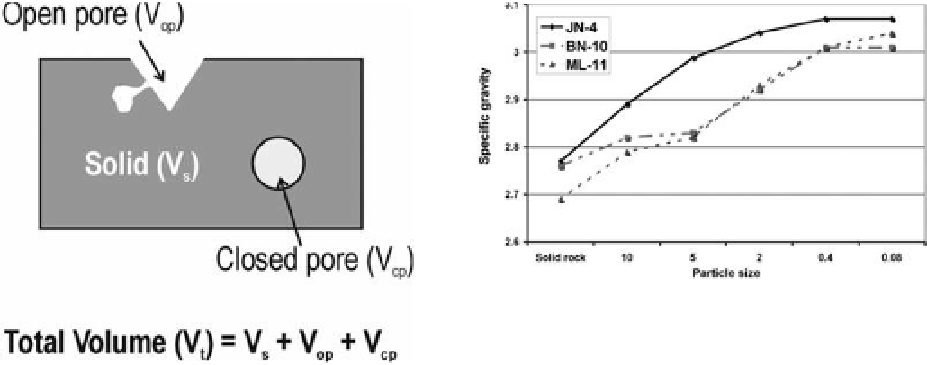Environmental Engineering Reference
In-Depth Information
Figure 5. Variation between particle size and specific
gravity (G) in the three lapilli samples.
Figure 4. schematic diagram of a porous material
showing open pores and closed pores in a solid matrix.
gas pycnometer in the determination of skeletal
volume and density can be quite high, but relies on
the use of a pure analysis gas being free of mois-
ture. For this reason, the gas is a pure gas or dry
air, and the sample is pre-treated in a vacuum oven
to remove volatiles. helium typically is the gas used
because it readily diffuses into small pores.
although helium pycnometry is an analytical
method to determine the material volumes or den-
sities by gas displacement, porosity information is
a by-product of volume determinations.
First of all, dry bulk density (
γ
d
) was determined
for each sample. secondly, the specific gravity val-
The specific gravity of the sample with particle size
under 0.080 mm is the highest and it is considered
to be the real one (
γ
s
). The specific gravity of the
rest of samples, where enclosed air-filled pores
exist and helium does not penetrate, is smaller
than the real one. Those values are called “appar-
ent” (
γ
s,ap
) or skeletal.
shape of particles makes a “package” effect on
each layer.
3.2
New sampling and lab tests
lapilli long-term behaviour is highly influenced by
the pore size distribution and the ratio of open to
closed porosity. it is very difficult to quantify these
micropores by water absorption tests because of
two main reasons: some pores are too small to be
penetrated by water and a certain percentage of
the pores are isolated.
The use of helium pycnometry allows to detect
and quantify this closed porosity made of non-
connected pores, as well as to describe the porous
net of this material.
To this end, basanite to basalt lapilli from three
Pleistocene and well preserved cinder cones of
Gran canaria island have been sampled: Jinámar
(Jn-4), Bandama (Bn-10) and Monte lentiscal
(Ml-11). The selected samples have in common
that they were taken from points which are close
(<30 m) to the volcanic crater (or central erup-
tion vent) and sampling was done on recent slope
cuts and at a depth of 2-5 m, from non weathered
zones.
all the samples were prepared to be analysed:
solid rock fragments crushed to different parti-
cle sizes: <10 mm, 5 mm (5 Une sieve), <2 mm
(2 Une sieve), <0.63 mm (0.63 Une sieve) and
<0.080 mm (0.080 Une sieve) were dried in an
oven until constant mass was reached.
specific gravity values (γ) were obtained follow-
ing the procedure asTM num. 5550-94 in an auto
Pycnometer 1330.
a gas pycnometer operates by detecting the pres-
sure change resulting from displacement of gas by
a solid object. The accuracy and precision of the
3.3
Calculation procedure
The total porosity would be defined as the sum of
open pores and closed pores related to the total
volume of each lapilli sample:
VV
V
+
γγ
γ
op
cp
(1)
s
d
n
=
=
total
t
s
For the particles under 0.080 mm the whole total
porosity is equal to the open porosity, while the rest
of particles show a certain percentage of isolated
pores which make the result at the pycnometer to
be lower than the real one. From this “apparent
specific gravity” (
γ
s,ap
), open porosity is calculated.
==
γ γ
γ
V
V
op
sap
,
d
(2)
n
open
t
sap
,

















